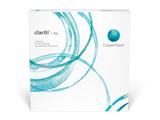Are you thinking about swimming with your contact lenses? Don’t.
The American Optometric Association and the U.S. FDA recommend that you avoid going into water while you’re wearing contact lenses. This includes lakes, the ocean, swimming pools, hot tubs, and even showers.
Why? The water may contain many unseen threats to your eyes. Your contact lenses might trap some of these microorganisms, resulting in harmful after effects.
One of these threats is Acanthamoeba keratitis (eh-can-tha-mee-bah kehr ah tie-tus). Acanthamoeba species are ubiquitous microscopic organisms found in the soil and lake water. “Keratitis” refers to an inflammation of the cornea.
According to the AOA, Acanthamoeba rarely cause infection. But when Acanthamoeba keratitis does strike, the results can be extremely serious and even threaten your vision.*
Symptoms listed by the AOA include:
- A red, painful eye infection
- Blurred vision with a foreign body sensation, tearing, and a sensitivity to light
- An usually long period of red, irritated eyes—even after removing your contacts
Organisms such as Acanthamoeba usually wash away from your eyes without contacts. But they could potentially infect you even without wearing contacts.
Avoid using tap water for rinsing or storing contacts
There’s a reason why we need to clean and disinfect contacts we remove and put on again using the proper products prescribed by your eye doctor: It helps get rid of organisms and keep your eyes healthy.
For best results, use the “rub and rinse” regimen method—even if you have “no rub” solution.
Daily disposable contacts may help reduce the risk of eye infections. But be aware, wearing them doesn’t completely eliminate the risk of an infection occurring. However, wearing daily disposables will help you in other ways, like avoiding the need for daily cleaning routines and provide you with a fresh, new pair every day.
Always follow your eye doctor’s recommendations for wearing and cleaning your contact lenses. Don’t try to save a few pennies by topping off old contact lens cleaning solution with new.
The AOA also recommends replacing your contact lens storage case every three months, if not sooner. Try to keep it away from the toilet and let the case remain open and dry between cleanings.
Following good hygiene habits is important when wearing contacts.
Ask your eye doctor about guidelines for contact lens care
Your optometrist is there to do more than simply prescribe new lenses for you.
Feel free to ask questions about guidelines for wearing contacts if you don’t understand anything your eye doctor tells you. And if you should encounter any eye pain, whether you wear contacts or not, contact a medical professional immediately.
You only have two eyes. Take care of them.





